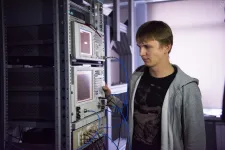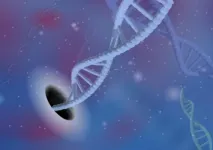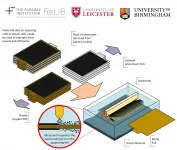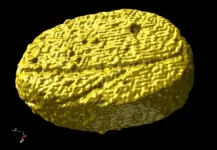(Press-News.org) Skoltech researchers and their colleagues from Russia and the UK investigated the safety and efficacy of new chemistry in antisense oligonucleotides used to treat spinal muscular atrophy (SMA), a debilitating genetic disease. Their results may lead to the development of drugs with less toxicity and fewer injections needed thanks to prolonged action. The paper was published in the journal Nucleic Acid Therapeutics.
Antisense oligonucleotides are single stranded chemically modified fragments of DNA that target pre-messenger RNA, short bits of genetic information a ribosome reads to make a protein. Depending on how a particular antisense oligonucleotide works, the target mRNA can either be destroyed or undergo subtle changes in how it's spliced, i.e. how exons, the coding regions, are excluded or included in the final mRNA.
Antisense oligonucleotides are good at targeting so-called monogenic disorders, where the cause of the disease stems from one particular gene/protein. A common example of such disease is spinal muscular atrophy (SMA); people with this disease lose a functional protein encoded by gene SMN1, and even though the human genome contains a nearly identical copy, SMN2, the mRNAs transcribed from this gene lack just one necessary exon, which leads to a poorly functioning protein.
To help the cells successfully use SMN2 instead of SMN1, an antisense oligonucleotide can interfere with splicing of the precursor to mature mRNA that includes a particular exon. That is how nusinersen, the clinically approved antisense oligonucleotide against SMA marketed as Spinraza®, works.
Timofei Zatsepin, Associate Professor at the Skoltech Center of Life Sciences, CLS Senior Research Scientist Olga Sergeeva and their colleagues studied alternatives to phosphorothioate groups in splice switching oligonucleotides. Previously, Dr. Stetsenko from Novosibirsk state university had developed oligonucleotides with methanesulfonyl (mesyl, μ) or 1-butanesulfonyl (busyl, β) phosphoramidate groups.
"Phosphorothioate is the key chemical modification of nucleic acids developed by Prof. Fritz Eckstein in late 1960s that is present in almost all oligonucleotide drugs approved so far. It improves stability, pharmacodynamics, and pharmacokinetics of oligonucleotides, but demonstrates significant toxicity that limits applications of oligonucleotide drugs. During the last 30 years, many alternatives were developed, but we do believe that mesyl phosphoramidates are superior to other phosphate mimics in therapeutic oligonucleotides," Zatsepin said.
The new compounds are a bit unusual as their structure is quite confusing when one sees the formula for the first time. "You expect that such a bulk group should strongly interfere with all intracellular interactions. However, our colleagues from Novosibirsk, led by Dr. Dmitry Stetsenko, previously demonstrated that μ-oligonucleotides are much less toxic than PS oligonucleotides, while duplexes of μ-oligonucleotides with DNA are good substrates of RNAse H - a key enzyme for mRNA degradation via antisense mechanism," Zatsepin noted.
The researchers were inspired by these results and looked, among other things, for splice switching oligonucleotides with potentially prolonged action. Nusinersen is administered several times a year via an injection into the spinal canal, so fewer injections would improve the quality of life for patients with SMA.
The team was able to test the activity of novel antisense oligonucleotides in vitro in SMA patient-derived fibroblasts and in vivo in a neonatal mouse model of SMA. "In our study we found that μ-oligonucleotides were active in vitro, while in vivo the efficacy was lower in comparison to nusinersen at the same dose. As μ-oligos are more stable and less toxic in vivo than PS oligos, we propose that μ-oligos used in higher doses can provide the same efficacy together with more prolonged action - this study is under development now," Zatsepin explained.
INFORMATION:
Other organizations involved in this research include the University of Oxford, Serbsky National Medical Research Center for Psychiatry and Narcology, Lomonosov Moscow State University, Novosibirsk State University, and the Institute of Cytology and Genetics, Siberian Branch of the Russian Academy of Sciences.
Skoltech is a private international university located in Russia. Established in 2011 in collaboration with the Massachusetts Institute of Technology (MIT), Skoltech is cultivating a new generation of leaders in the fields of science, technology and business, is conducting research in breakthrough fields, and is promoting technological innovation with the goal of solving critical problems that face Russia and the world. Skoltech is focusing on six priority areas: data science and artificial intelligence, life sciences, advanced materials and modern design methods, energy efficiency, photonics and quantum technologies, and advanced research. Web: https://www.skoltech.ru/
Russian scientists have experimentally proved the existence of a new type of quasiparticle - previously unknown excitations of coupled pairs of photons in qubit chains. This discovery could be a step towards disorder-robust quantum metamaterials. The study was published in Physical Review B.
Superconducting qubits are a leading qubit modality today that is currently being pursued by industry and academia for quantum computing applications. However, the performance of quantum computers is largely affected by decoherence that contributes to a qubits extremely short lifespan and causes computational errors. Another ...
Pioneering research has revealed the erosion of ancient sediments found deep beneath Antarctic ice could be a vital and previously unknown source of nutrients and energy for abundant microbial life.
The study, led by the University of Bristol and published today in Nature's Communications Earth & Environment journal, sheds new light on the many compounds supporting various microbes which form part of a huge subglacial ecosystem.
Lead author Dr Beatriz Gill Olivas, a Post-Doctoral Research Associate at the University of Bristol, said: "Although the study focused on samples obtained from a single ...
During summer 2020, the Yangtze River basin experienced persistent, record-breaking meiyu rainfall. Likewise, the region suffered from severe flooding and water damage as accumulated rainfall broke records dating back to 1954. Regions outside the meiyu rain belt received significant summer rainfall as well, including Beijing, located in northeastern China.
Typically, an above average meiyu rainfall season follows a strong El Niño during the previous winter. However, summer 2020 followed a neutral El Niño-Southern Oscillation (ENSO) event. Therefore, scientists are working ...
A stimulating environment keeps the "hippocampus" - which is the brain's memory control center - young, so to speak. Causes of this are molecular mechanisms that affect gene regulation. These current findings from studies in mice provide clues as to why an active, varied life can help preserve mental fitness in old age. Researchers from the DZNE and the Center for Regenerative Therapies Dresden (CRTD) at the Technische Universität Dresden report on this in the journal Nature Communications.
Human DNA - and this also applies to mice - contains thousands of genes. However, it is not only the genetic blueprint that is decisive for the function of a cell and whether it is healthy or not, but above all which genes can be switched on or off. ...
FECYT - Spanish Foundation for Science and Technology - presented today at the headquarters of the National Museum of Science and Technology, MUNCYT, IN Alcobendas, the results of the third Social Perception Survey of scientific aspects of the COVID-19 in a debate moderated by Pampa García Molina, Editor-in-Chief of the SINC Agency, in which Raquel Yotti, Director of the Carlos III Health Institute of Madrid, Josep Lobera, Professor of Sociology at the Universidad Autónoma de Madrid (UAM) and scientific director of the Social Perception Survey on the scientific aspects of COVID-19 and ...
Polymers are long, chain-like molecules which are everywhere in biology. DNA and RNA are polymers formed by many consecutive copies of nucleotides coupled together. When being transported within or between cells, these biological polymers must pass through nanometre-sized holes called "nanopores".
This process also underlies a rapidly developing method for analysing and sequencing DNA called nanopore sensing.
The study, published in the journal END ...
Researchers at the University of Leicester have developed a new method to recycle electric vehicle batteries using a ground-breaking new approach that many will have experienced in the dentist's chair.
The Faraday Institution project on the recycling of lithium-ion batteries (ReLiB) led by Professor Andy Abbott at the University of Leicester used a new method, involving ultrasonic waves, to solve a critical challenge: how to separate out valuable materials from electrodes so that the materials can be fully recovered from batteries at the end of their life.
Current recycling ...
A new corona test developed at the University Hospital Bonn can analyze a large number of swabs simultaneously using sequencing technology and has a similarly high sensitivity as the common qPCR test. The innovative method offers great potential, especially for systematic testing in daycare centers, schools or companies. Today, the results of the study on the new Corona test have been published in the renowned journal "Nature Biotechnology".
Bonn, 6/29/2021 - In addition to vaccination, systematic testing of the population remains of central importance in order to effectively monitor and contain the spread of infections during the Coronavirus pandemic. Only in this way can the spread of the virus be effectively monitored and ...
Crystallization is one of the most fundamental processes found in nature - and it's what gives minerals, gems, metals, and even proteins their structure.
In the past couple of decades, scientists have tried to uncover how natural crystals self-assemble and grow - and their pioneering work has led to some exciting new technologies - from the quantum dots behind colorful QLED TV displays, to peptoids, a protein-mimic that has inspired dozens of biotech breakthroughs.
Now, a research team led by scientists at the Department of Energy's Lawrence Berkeley National Laboratory (Berkeley Lab) and UC Berkeley has developed a nanoparticle composite that grows ...
The electronic properties of graphene can be specifically modified by stretching the material evenly, say researchers at the University of Basel. These results open the door to the development of new types of electronic components.
Graphene consists of a single layer of carbon atoms arranged in a hexagonal lattice. The material is very flexible and has excellent electronic properties, making it attractive for numerous applications - electronic components in particular.
Researchers led by Professor Christian Schönenberger at the Swiss Nanoscience Institute and the Department of Physics at the University of Basel have now studied how the material's ...







